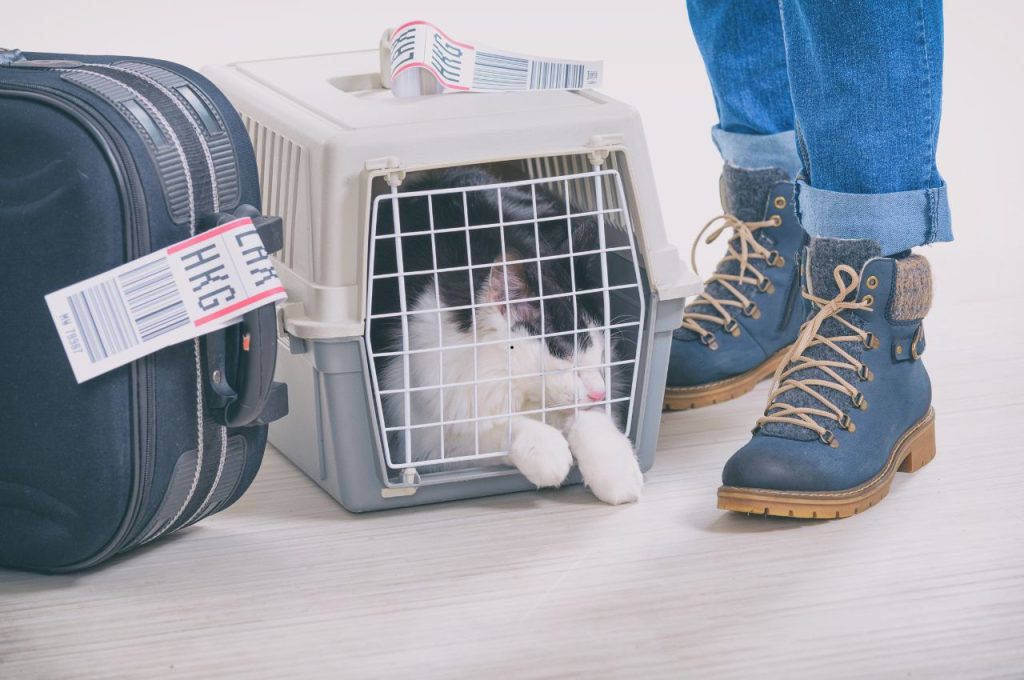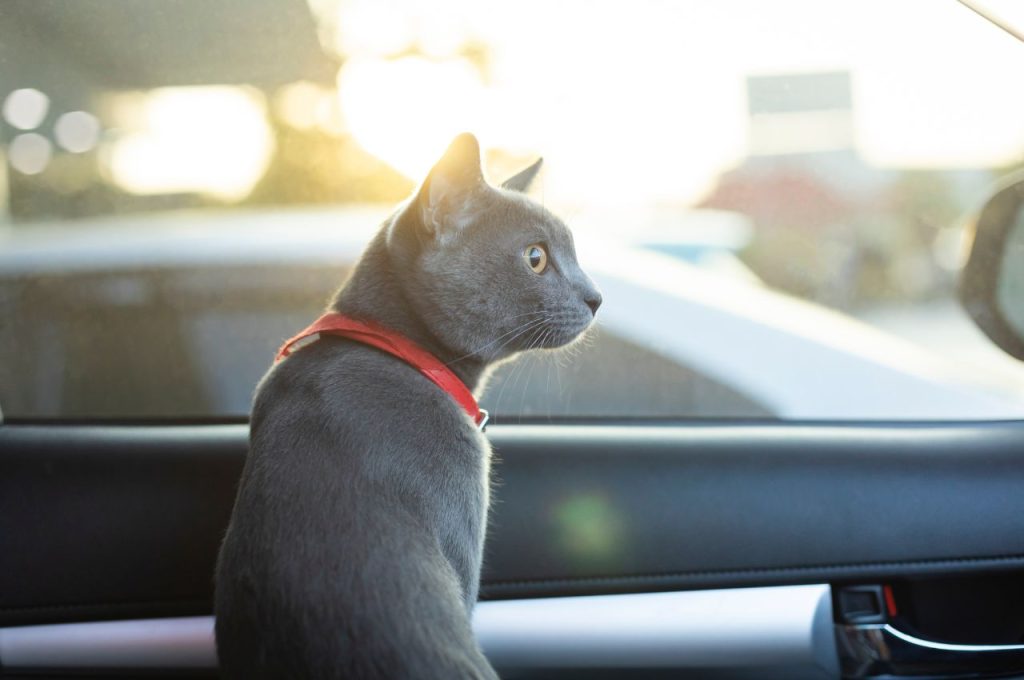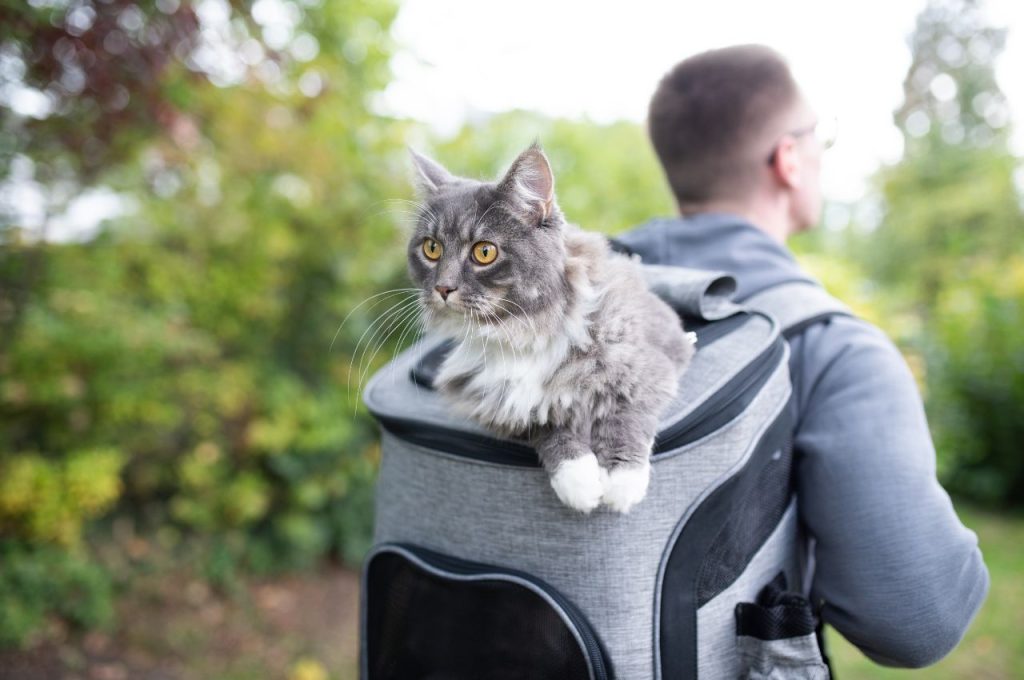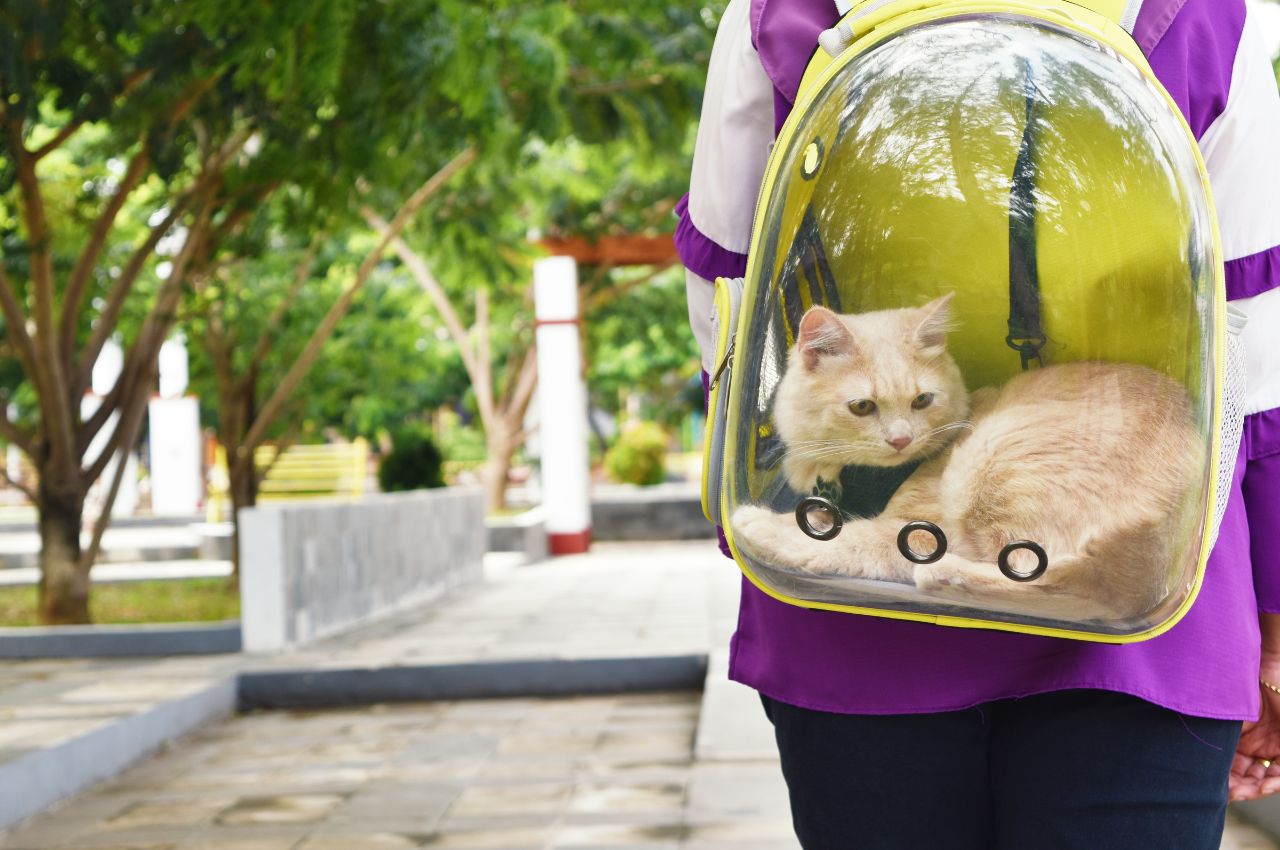To transport your cat, use a secure carrier and place familiar items inside for comfort. Keep the carrier level and avoid sudden movements to reduce stress.
Ensure proper ventilation and place the carrier in a safe, quiet area. Introduce the carrier gradually to help your cat feel more at ease with it. By following these steps, you can safely transport your feline friend to their destination without causing unnecessary anxiety. Remember to speak softly and provide reassurance during the journey to help keep your cat calm and comfortable.
Introduction to Feline Travel
It’s essential to prioritize safety and comfort. Use a sturdy, well-ventilated carrier with a soft blanket inside. Gradually acclimate your cat to the carrier before the trip to reduce stress. Secure the carrier in your vehicle and keep the environment calm. Regular breaks during long journeys for water and reassurance can make the experience more pleasant for your feline companion.

The Importance of Safety
When transporting your cat, safety should be the top priority. Securing your feline friend properly ensures a smooth and stress-free journey.
Understanding Cat Stress
Cats can experience anxiety during travel, which may manifest in various ways. Understanding these signs and addressing them is crucial for a comfortable trip.
Pre-travel Preparations
Preparing your cat for travel is essential to ensure a stress-free journey. The right preparations can make a significant difference in your cat’s comfort and well-being during transit. Here are some crucial pre-travel preparations to consider when transporting your cat:
Choosing The Right Carrier
Selecting an appropriate carrier is the first step in ensuring your cat’s safety and comfort during travel. Opt for a well-ventilated, sturdy carrier that provides enough space for your cat to stand, turn, and lie down comfortably. Consider choosing a carrier with a removable top for easy access during security checks.
Familiarizing Your Cat With The Carrier
Introducing your cat to the carrier well in advance of your travel date is crucial. Place the carrier in a familiar and comfortable space at home, and encourage your cat to explore and spend time in it. Gradually increase the time spent inside the carrier to help your cat acclimate to this new environment.
Consulting with a Veterinarian
Seek guidance from a veterinarian before traveling with your cat, especially if they have any underlying health concerns. A vet can provide valuable advice on managing your cat’s anxiety, motion sickness, or any specific health needs during the journey. Additionally, ensure that your cat is up-to-date on vaccinations and obtain any necessary health certificates required for travel.
Carrier Comfort Enhancements
Creating a comfortable environment in the carrier can help reduce your cat’s stress during transportation. Here are some simple ways to enhance your cat’s comfort:
Soft Bedding
Provide soft bedding in the carrier to make it cozy for your cat. This helps reduce anxiety and makes the journey more comfortable. Ensure the bedding is familiar and has your cat’s scent. Soft bedding also provides cushioning and stability during transport, contributing to a smoother ride.
Calming Pheromones
Use calming pheromones to help relax your cat during the journey. These products, available as sprays or diffusers, can reduce anxiety and make transport smoother. Spray the carrier 15 minutes before travel and ensure your cat has a familiar blanket or toy for added comfort.
Favorite Toys
Include your cat’s favorite toys to keep them entertained and calm while traveling. How do I transport my cat? Use a secure carrier, and place familiar toys inside. This helps reduce stress and provides comfort, making the journey more pleasant for your feline friend.
Training Your Cat for Travel
When it comes to transporting your cat, proper training can make all the difference in ensuring a stress-free and comfortable journey for both you and your feline friend. Gradual introduction and positive reinforcement techniques are key to helping your cat feel at ease during travel.
Gradual Introduction
Introducing your cat to the idea of travel should be done gradually, allowing them to adjust to new environments and experiences. Start by getting your cat familiar with their carrier, leaving it out in their living space so they can explore and become comfortable with it. Place treats or toys inside the carrier to create positive associations.
Once your cat is comfortable with the carrier, start taking short trips with them in the car to acclimate them to the motion and sounds. Start with brief drives around the block, gradually increasing the duration of the trips. This will help your cat build confidence and reduce anxiety associated with travel.
Positive Reinforcement Techniques
Using positive reinforcement techniques is crucial when training your cat for travel. Reward your cat with treats, praise, or playtime whenever they show calm behavior or willingly enter the carrier. By associating travel with positive experiences, your cat will start to view it as a normal and enjoyable part of their routine.
Additionally, creating a cozy and familiar environment inside the carrier can help your cat feel more secure. Place their favorite blanket or bedding inside, along with familiar toys or a piece of clothing that smells like you. The familiar scents will provide comfort and reassurance throughout the journey. During travel, it’s essential to remain calm and composed. Cats are sensitive to their owners’ emotions, so staying relaxed will help them feel more at ease. Avoid sudden movements or loud noises that may startle your cat and reinforce their negative associations with travel.
In conclusion, training your cat for travel requires patience, consistency, and positive reinforcement. Gradually introducing your cat to the carrier and using rewards to create positive associations will help them feel comfortable and secure during the journey. Remember, a well-trained and relaxed cat will make for a smoother and more enjoyable travel experience for both of you.
Travel Day Checklist
Transporting your furry friend can be a stressful experience for both you and your cat. However, with a little bit of preparation and the right approach, you can make it a smooth and safe journey for your pet. Having a travel day checklist can help ensure that you don’t forget anything important. Here’s what you need to know.

Feeding and Medication Schedule
It’s important to keep your cat’s feeding and medication schedule in mind when you’re traveling. Make sure to pack enough food and water for the journey, as well as any medications your cat needs. If your cat gets anxious during travel, consider talking to your vet about anti-anxiety medication that can help keep them calm.
Carrier Placement and Security
Your cat’s carrier should be secure, comfortable, and well-ventilated. Make sure the carrier is big enough for your cat to stand up, turn around, and lie down comfortably. During travel, place the carrier in a secure location, such as the back seat of your car or the floor of the plane cabin. Make sure the carrier is fastened securely so that it doesn’t move around during the journey.
Before you set off on your journey, make sure to check that the carrier is in good condition. Check for any holes or tears in the carrier, and make sure the zippers and latches are working properly. Finally, place a familiar blanket or toy inside the carrier to make your cat feel more at ease.
Traveling with your cat can be a fun and rewarding experience. With a little bit of preparation, you can make sure that your furry friend stays safe, healthy, and happy throughout the journey. Remember to keep your cat’s feeding and medication schedule in mind, and make sure their carrier is secure and comfortable. With these tips in mind, you’ll be ready to hit the road with your feline friend.
Modes of Transportation
When it comes to transporting your beloved cat, there are several modes of transportation to consider. Each option has its own set of guidelines and tips to ensure a safe and stress-free journey for both you and your feline friend. Whether you’re traveling by car, plane, or public transportation, it’s important to be well-prepared and knowledgeable about the specific requirements for each mode of transport.
Car Travel Tips
If you’re planning a road trip with your cat, there are a few important car travel tips to keep in mind:
- Secure your cat in a well-ventilated carrier or crate to prevent any accidents or injuries during the journey.
- Place the carrier on the back seat or in the rear area of the car, securing it with a seatbelt or other restraints to ensure stability.
- Make sure your cat has access to fresh water and a litter box during the trip, and take regular breaks to allow for bathroom breaks and stretching.
- Avoid leaving your cat unattended in the car, especially in extreme temperatures.
Flying with a Cat
If you’re planning to travel by plane with your cat, there are specific guidelines and preparations to follow:
- Contact the airline in advance to understand their pet travel policies and to make necessary arrangements for your cat.
- Ensure your cat’s carrier meets the airline’s requirements for size, ventilation, and security.
- Obtain a health certificate from your veterinarian to confirm that your cat is fit to fly.
- Consider booking a direct flight to minimize travel time and avoid unnecessary stress for your cat.
- Place familiar items, such as a blanket or toy, in the carrier to provide comfort during the journey.
Public Transportation Guidelines
If you’re using public transportation, such as buses or trains, with your cat, it’s important to be aware of the following guidelines:
- Check the transportation provider’s rules and regulations regarding pet travel, as some may have restrictions or specific requirements.
- Ensure your cat is properly secured in a carrier or crate to prevent any disruptions or accidents during the journey.
- Be mindful of other passengers and respect their space by keeping your cat’s carrier on your lap or under the seat.
- Consider off-peak travel times to avoid crowded conditions and provide a more comfortable experience for your cat.
Managing Travel Anxiety
Transporting your cat can be a stressful experience for both you and your feline friend. Understanding the signs of stress in your cat and learning how to calm them can help make the journey more manageable.
Signs of Stress
Recognizing the signs of stress in your cat is crucial for addressing their travel anxiety. Look out for excessive meowing, panting, pacing, hiding, and excessive grooming. These behaviors can indicate that your cat is feeling overwhelmed by the travel experience.
How to Calm Your Cat
There are several ways to help calm your cat during travel. Start by acclimating them to the carrier well in advance of the trip. Use pheromone sprays or calming collars to create a soothing environment. Additionally, covering the carrier with a blanket can provide a sense of security. Playing calming music or using a comforting blanket can also help reduce their anxiety.
Post-travel Care
Post-travel care is crucial for ensuring your cat’s well-being and comfort after a journey. It’s essential to help your feline friend settle into the new environment and monitor for signs of stress. By taking the right steps, you can ensure a smooth transition for your cat and provide the necessary support for their post-travel needs.
Settling in The New Environment
- Creating a Safe Space: Designate a quiet area in your new home where your cat can feel secure. Provide familiar items such as their bed, toys, and scratching posts to help them feel more at ease.
- Gradual Introduction: Introduce your cat to different areas of the house gradually, allowing them to explore at their own pace.
- Be Patient: Give your cat time to adjust and avoid overwhelming them with too much activity or attention.
Monitoring for Post-travel Stress
- Observing Behavior: Keep an eye on your cat’s behavior for signs of stress, such as hiding, excessive meowing, or changes in appetite.
- Comfort and Reassurance: Offer gentle reassurance and extra attention to help your cat feel secure in their new surroundings.
- Veterinary Checkup: Schedule a visit to the veterinarian if you notice any concerning symptoms or behaviors, as they can provide professional guidance on managing post-travel stress.
Legal and Health Considerations
Transporting your cat requires careful consideration of both legal and health factors to ensure a safe and stress-free journey. It is essential to be aware of the travel documentation required, understand quarantine regulations, and prioritize your cat’s health throughout the process.

Travel Documentation
Before embarking on a journey with your cat, it is crucial to gather the necessary travel documentation. This typically includes identification and proof of ownership, such as a microchip or collar tag with your contact information. Additionally, certain countries or airlines may require specific vaccination records or health certificates. It is recommended to consult with your veterinarian and the destination country’s embassy or consulate to ensure you have all the required documentation in order.
Understanding Quarantine Regulations
Quarantine regulations vary depending on the destination country. Some countries have strict quarantine measures in place to prevent the spread of diseases, while others have more relaxed policies. It is vital to research and understand the quarantine regulations of your destination well in advance. This will help you prepare accordingly and ensure that your cat meets all the necessary requirements to avoid any complications upon arrival.
For instance, some countries may require a period of quarantine upon arrival, during which your cat will be kept in a designated facility for observation. Others may have specific vaccination requirements or require additional paperwork. By familiarizing yourself with these regulations, you can make the necessary arrangements and ensure a smooth transition for your feline friend.
Ensuring Your Cat’s Health
Prioritizing your cat’s health is of utmost importance when transporting them. It is crucial to schedule a visit to the veterinarian before the journey to ensure your cat is in good health and up to date on all vaccinations. Your vet can also provide guidance on any additional precautions or medications that may be necessary for the journey.
During the journey, ensure that your cat remains comfortable and stress-free. Provide a well-ventilated carrier with enough space for them to move around comfortably. Additionally, make sure to pack essential items such as food, water, and any necessary medications. Regular breaks and opportunities for your cat to stretch their legs and use the litter box are also important.
By adhering to legal requirements, understanding quarantine regulations, and prioritizing your cat’s health, you can ensure a smooth and safe transport for your feline companion. Taking the necessary precautions will help minimize stress and ensure a positive travel experience for both you and your beloved cat.
Conclusion
Transporting your cat requires patience and planning. Remember to use a secure carrier. Keep your cat comfortable and calm during the journey. Safeguard your pet’s well-being by following these tips. With the right approach, you can ensure a stress-free travel experience for your feline companion.
